Ancient cultures seem to have regarded a Sacred Place as a Place where Heaven and Earth could be seen to meet in Harmony at the Horizon.
Thus they had an effective luni-solar horizon calendar. Prehistoric monuments mark observing positions.
These examples show how individual sectors of the horizon profile were accurately fitted, within the context of an overall 360° "best fit".
- Orange Solar trajectories split the tropical year into 48 "Tweeks" (7.6 day mean) that are better regarded as quarter-months.
- Solid Blue Lunar lines split cyclical lunistice position variation into 16 periods of about 14 months each.
- The year has been split into 16 parts by repeated halving; then each sixteenth part divided into three.
- Lunistices are the most northerly and southerly moons of the month.

From this
Stone Circle at Inchybegga we are looking axially out between the portal stones to the north-east.
The highest top of the indicated hill marks summer solstice sunrise, the south basal step of the hill is the summer cross-quarter and the south hilltop is halfway in time between these two.
The equinox is at the lowest point of the eastern horizon. Clearly a good fit for half the year and not just the axial indication of a solstice.
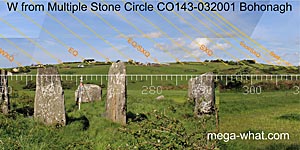
The axis of this
Stone Circle at Bohonagh is aligned towards the equinox sunset which is at the southern edge of the southmost top of the hill.
North of it, the summer cross-quarters are at the northern edge of the northmost top. The day half-way between them is in the dip, at the foot of the northern upslope.
The summer solstice is off the end though, falling on distant hills to the north.
The edge of the local hill actually marks a sunset that defines the period within which the closest full moon to the solstice must occur.
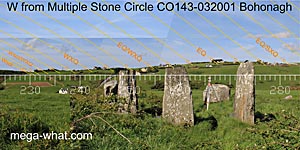 South of the circle axis, the winter solstice is also on more distant ground.
Again, the edge of the hill marks a sunset that defines the period within which the closest full moon to the solstice must occur.
Cross-quarter is at the first step in the slope leading up to the equinox and the day half-way between it and the equinox is at the second step.
Thus the whole year was fitted nicely across Burgatia hill with the equinox indicated by the monument axis.
South of the circle axis, the winter solstice is also on more distant ground.
Again, the edge of the hill marks a sunset that defines the period within which the closest full moon to the solstice must occur.
Cross-quarter is at the first step in the slope leading up to the equinox and the day half-way between it and the equinox is at the second step.
Thus the whole year was fitted nicely across Burgatia hill with the equinox indicated by the monument axis.
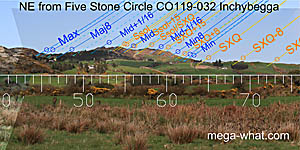
Back at
Inchybegga Stone Circle we can now consider the moon's 18.6 year cycle. Lunar minor standstill is at the first step in the slope above the cross-quarter.
Major standstill is at the south basal intersect of the next hill. The cycle's midpoint is at a minor break between the central dip and the north hilltop.
Eighths and sixteenths also coincide with useful markers.
The North & South endpoints of the moon's monthly travels are called lunistices and always fall somewhere in the zones marked by blue lines.
Distance traveled expands and contracts regularly over 18.6 years. The solid blue lines split this endpoint variation into 16 parts of about 14 months each
[Prehistoric Lunar Calendar]. Dotted lines halve those time intervals.
The rate of change is quite big in the middle but at both ends it is very small and at those times, known as standstills, the monthly lunistices linger around the same positions for a couple of years.
The next four pictures demonstrate that this accuracy of fit is not just in axial directions but all the way round:
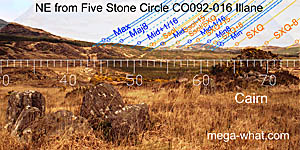 At Illane Stone Circle the axial reverse points north of the luni-solar zone because of the circle's orientation to the south-west.
The minor end of the lunistice cycle is at the basal step of a hill, the lunar midpoint is in the dip between two hills with the solstice at the foot of the upslope.
The major end of the lunistice cycle is at the basal step of the following upslope.
At Illane Stone Circle the axial reverse points north of the luni-solar zone because of the circle's orientation to the south-west.
The minor end of the lunistice cycle is at the basal step of a hill, the lunar midpoint is in the dip between two hills with the solstice at the foot of the upslope.
The major end of the lunistice cycle is at the basal step of the following upslope.
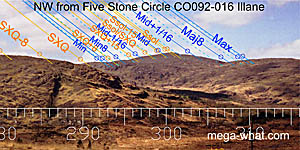 To the north-west the equivalent setting points start with the lunar minor standstill at the basal step of a hilltop.
The solstice is on the hilltop and the notch at the base of the northern slope marks an eighth part of the lunistice cycle, then the major end is on the next upslope, terminating just before a minor break in the ridge.
To the north-west the equivalent setting points start with the lunar minor standstill at the basal step of a hilltop.
The solstice is on the hilltop and the notch at the base of the northern slope marks an eighth part of the lunistice cycle, then the major end is on the next upslope, terminating just before a minor break in the ridge.
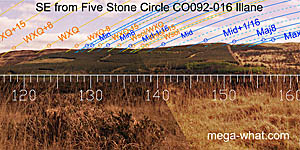 The south-eastern horizon profile is less dramatic but the lunistice range again starts at a dip/step with the winter solstice at the next one.
The next significant break is a lunar eighth again with the major standstill usefully occurring over a slight hump in the ridge.
The south-eastern horizon profile is less dramatic but the lunistice range again starts at a dip/step with the winter solstice at the next one.
The next significant break is a lunar eighth again with the major standstill usefully occurring over a slight hump in the ridge.
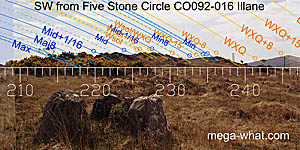 The south-western axis of the circle indicates very local ground in the general direction of the major side of the lunistice range.
This axis is at the opposite end of the spectrum to the first two shown. It is not specific, nor does it point towards the best horizon sector.
The observer's attention is being drawn to a general spread of horizon that would otherwise be easily overlooked or dismissed.
The south-western axis of the circle indicates very local ground in the general direction of the major side of the lunistice range.
This axis is at the opposite end of the spectrum to the first two shown. It is not specific, nor does it point towards the best horizon sector.
The observer's attention is being drawn to a general spread of horizon that would otherwise be easily overlooked or dismissed.
© Michael Wilson.








